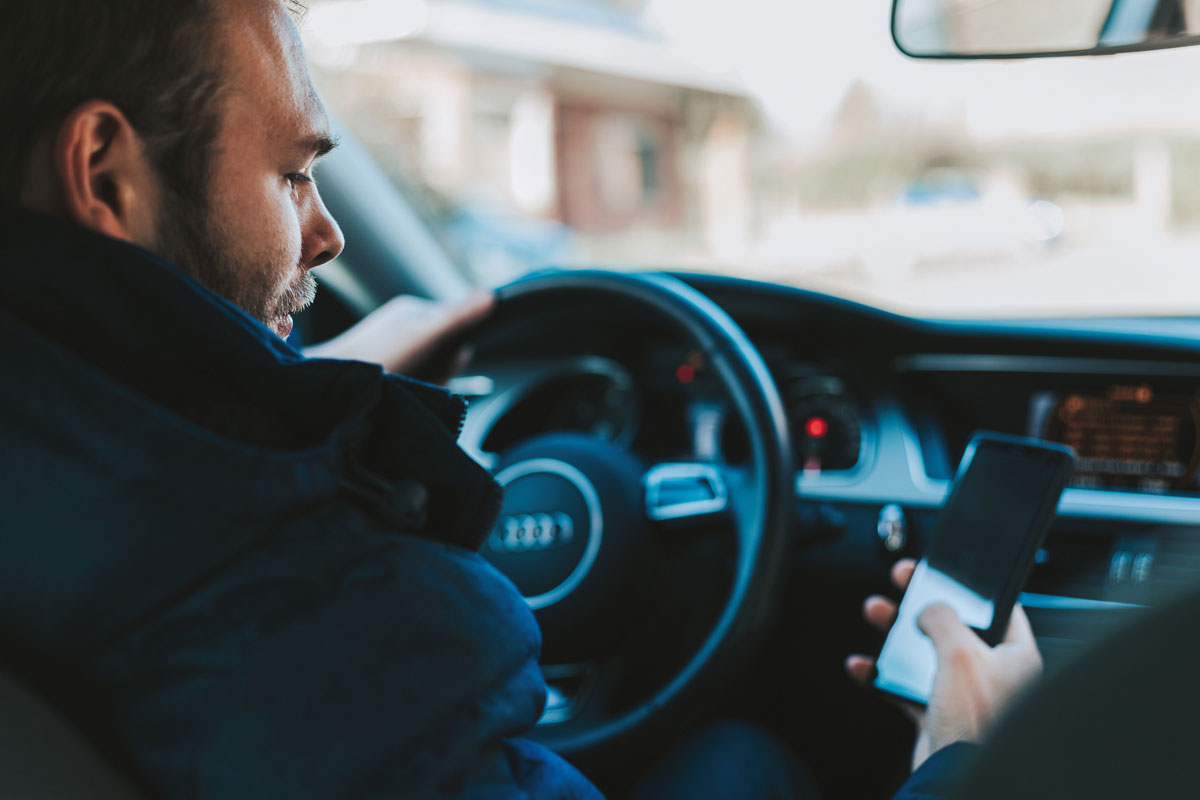It’s the middle of lunch hour traffic. You’re driving from meeting to meeting, fitting in a quick bite as you go, and looking for a good song on the radio. You have every intention of being a courteous, law-abiding driver. Then your cell phone rings, or maybe you get a notification from an app. Should you check to see if it’s important?
We all have the best of intentions when we get behind the wheel of a car, but we may not realize how each distraction – glancing at text messages, turning around to settle a fight between the kids, or even eating lunch on the go – can impact not only our safety, but the safety of others.
Driving requires the simultaneous use of focus, attention, coordination, and split-second decision making. When distractions behind the wheel compromise any one of these skills, the driver immediately becomes more likely to be involved in a car accident. Distracted driving is extremely dangerous. Every year distracted drivers cause thousands of accidents on our roads and highways.
According to the Occupational Safety and Health Administration (OSHA)[1]:
- When a driver talks on a cell phone, reaction time is delayed just as if the driver were drunk.
- With each additional 1 million text messages, fatalities from distracted driving rose more than 75%.
- People under the age of 20 are involved in more fatal crashes caused by distractions than any other age group.
What Do Drivers Consider Distractions?
Most drivers don’t consider themselves distracted while driving. People assume that they can handle multiple tasks at the same time without any loss of concentration. That may work outside of the car, but things change once a person gets behind the wheel. Drivers must always be focused and ready to respond to the actions of other drivers, road conditions, and unforeseen circumstances. The National Highway Traffic Safety Administration (NHTSA) estimates that the average text pulls the driver’s eyes away from the road for five seconds. At 55 miles an hour, a car will travel the length of a football field in that time. [2]

What Counts as Distracted Driving?
Distracted driving is any activity that occurs while operating a motor vehicle that could divert a person’s focus away from the essential task of driving. This risky behavior endangers the lives of drivers, their passengers, other drivers and pedestrians. Distracted driving includes the following actions:
- Talking to or reacting to other passengers in the car
- Adjusting the music, such as a radio, CD player, or MP3 player
- Eating or drinking while driving
- Making or receiving phone calls
- Texting or reading a text
- Putting on lipstick, applying make-up, fixing your hair or shaving
Many people will also use map and navigation apps on their phones. These too can be a distraction, particularly if you get lost. Just like with a paper map, you should pull over and figure out where you are going.
Distracted driving is becoming more prevalent across our country despite a focus on preventing this dangerous behavior. The use of cell phones while driving continues to receive national attention and states have either passed or are working to pass legislation that will prohibit the use of cell phones while driving. According to the NHTSA statistics, 20% of car wrecks involving injuries in 2009 were caused by distracted driving. [2]
Drivers turn to cell phones or smart phones while behind the wheel in an attempt to multitask. Some drivers still just hold their phones to their ears while making phone calls, however this practice is declining. Between 2014 and 2015, the number of drivers using their phones in this manner fell from 4.3% to 3.8%. On the other hand, the percentage of drivers visibly manipulating their phones (be it to text, email, interacting with apps, etc.) has increased, from 1.3% in 2011 to 2.2% in 2015.[3]
Texting while driving is the most dangerous distracted driving activity because it combines all three types of driving distraction
- Visual: taking your eyes off the road,
- Manual: taking your hands off the wheel, and
- Cognitive: taking your mind off the task of driving.
Although texting while driving is banned for all drivers in 45 states and the District of Columbia, nine people are killed and 1,153 people are injured each day in crashes across the country that involve distracted drivers.[4][5]
Know the Laws Restricting Cell Phone Use in the States You Drive in Regularly
In Virginia, it is illegal to text while driving. And if you are under the age of 18, it is illegal to use your phone at all while driving.[6] The same rules apply in North Carolina.[7] Maryland, Delaware, and D.C. laws are even stricter. These states do not allow any driver, regardless of age, to use hand-held devices while driving.[6] Before you travel, know the laws. The Insurance Institute for Highway Safety maintains a comprehensive list.
“At any given daylight moment across America, approximately 660,000 drivers are using cell phones or manipulating electronic devices while driving.”[8]
Studies conducted by the National Highway Traffic Safety Administration demonstrate a direct relationship between driver inattention and automobile accidents. Just glancing away from the roadway for more than two seconds can double your risk of a crash or near crash. Engaging in more complex visual or manual tasks while driving can raise that risk even higher. It goes without saying that driving while drowsy is always dangerous and increases the risk of an accident.
Remember, however, that not every glance away from the road ahead is dangerous. Quick looks into rear or side view mirrors to check for approaching vehicles or other obstacles can actually decrease your risk of a crash. The motor vehicle driver who periodically scans his surroundings, specifically looking for potential hazards, is a safer driver.
Is Distracted Driving a New Phenomenon?
Drivers have been primping, smoking, and eating behind the wheel ever since motor vehicles took to the roads over a century ago. Why is there such concern over inattentive drivers now? Within the last two decades, cell phone use has increased to the point where there are now over 250 million people in the United States who are wireless communication subscribers. Many of these subscribers regularly use their cell phones while they drive. Most people want to stay in touch with friends, relatives and associates. Teenage and young adult drivers are especially reliant on the new technology. Unfortunately, this attraction to technology translates into driver inattention, and it comes at a price.
According to a 2013 study by the NHSTA, almost half of all drivers (48.6%) say they answer incoming calls, and one of four drivers (23.9%) are willing to place outgoing calls.[10] This high frequency of cell phone use means there are more distracted drivers navigating our highways. The more inattentive drivers there are on the road, the more frequently these drivers will be involved in accidents.
Driving while you are engaged in a cell phone conversation is risky business. A recent University of Utah report declared that the impairment level for persons driving while talking on cell phones is comparable to that of motorists driving while intoxicated at the legal blood-alcohol limit. [13]
It is tempting to conclude that carrying on a cell phone conversation is safer than handling and dialing a cell phone. After all, once the phone connection is made and the conversation begins, you’re keeping your eyes on the road ahead, aren’t you? Studies show it is not just the physical act of reaching for the phone and dialing that raises the risk of involvement in a crash. It is also the mental concentration that comes with both listening to someone speak to you and formulating your verbal response. When you’re absorbed in a phone chat with a friend, your mind is focused on the conversation, not the road. Despite this reality, however, states are taking action to ban hand-held cell phone use based on the rationale that hands-free cell phone conversations are safer. In 2008, California enacted a ban on hand-held cell phone use by non-commercial drivers. New York, New Jersey, Connecticut, and Washington, D.C. have enacted similar legislation.

At present, these states are in the minority. Although more and more state legislatures are taking action to curb cell phone conversations by drivers, few states ban cell phone use altogether. Where there are bans, certain professions or jurisdictions are sometimes exempted. Nevertheless, more and more states are identifying specific categories of drivers for special regulation. Because cell phone use and text messaging is most prevalent among teenage drivers, states have become proactive in dealing with this age group. Seventeen states, including Virginia, Texas, and New Jersey, plus Washington, D.C., regulate cell phone use by novice drivers depending on their age and/or whether or not they have a learner’s permit or a provisional license. Fifteen states prohibit cell phone use by school bus drivers.
To date, legislators in Virginia have focused only on cell phone use by young drivers. Enacted in 2007, Virginia Code Section 46.2-334.01 provides that, “except in a driver emergency or when a vehicle is lawfully parked or stopped, the holder of a provisional driver’s license shall not operate a motor vehicle on the highways of the Commonwealth while using any cellular telephone or any other wireless telecommunications device, regardless of whether such device is or is not hand-held.” This provisional driver’s license restriction expires on the holder’s 18th birthday. Violation of the statute constitutes a traffic infraction. Multiple offenses may result in suspension of the juvenile’s privilege to drive for a period not to exceed six months. A judge may impose other penalties.
Of course, it is not only cell phone conversations that put motorists and others at risk. When, for example, a driver is drawn into conversation with his passengers, his ability to react quickly to trouble on the roadway ahead is also impaired. He is likely to brake more slowly and to follow other vehicles too closely. The bottom line is, although cell phone use is a common driver distraction which raises the risk of an accident occurring, drivers who habitually engage in other activities are also much more likely to be involved in crashes.
Educating Drivers to the Dangers of Distracted Driving
One underlying problem with distracted driving is public perception. Everyone knows that drinking and driving is wrong, but very few people have a full understanding of how focusing on other activities while driving is equally as dangerous. Talking on the phone, texting, fixing makeup in the mirror, adjusting music on the radio, eating and drinking, and talking to passengers in the car also put drivers and passengers at risk for potential accidents.
Education is key. One of the best ways to end distracted driving is to make people aware of the dangers.
Strategies for Eliminating Distractions while Driving
- Turn your phone off or put it in Airplane Mode until you reach your destination.
- Put your phone in the backseat so you are not tempted to check it.
- Text the person you are meeting to tell them you are on the way, and then put your phone away.
- If you are relying on maps or navigation apps to lead you to a destination, familiarize yourself with the route prior to departing. Use the audio function of navigation apps whenever possible.
- Create a music playlist or CD so you are not tempted to play with the radio.
- Give yourself a few extra minutes to check your appearance in the mirror once you have safely arrived at your destination.
- Pull over to a safe area and enjoy your food and drink before driving again.
- Keep conversations to a minimum to avoid being distracted by passengers.
- Pull over to a rest stop or safe area if needed for interactions with children in the car. You can talk or sing to keep them entertained but keep your eyes forward on the roadway. Come up with a strategy to keep young passengers occupied with audio books, videos, books, or road games like “I Spy”.
3 Things You Can Do to Prevent Distracted Driving
- Eliminate your own distractions while driving
- Use social media to tell others about the dangers of distracted driving.
- Take the pledge to drive distraction-free.[10]
You can help keep roadways safe by using these guidelines to minimize distractions. Sharing this information with others can save lives.
Sources:
[1] https://www.osha.gov/distracted-driving/index.html
[2] https://www.nhtsa.gov/risky-driving/distracted-driving
[3] National Highway Traffic Safety Administration’s “Driver Electronic Device Use in 2015” Report available at supra not 2.
[4] See Distracted Driving, IIHS & HLDI, http://www.iihs.org/iihs/topics/laws/cellphonelaws?topicName=distracted-driving.
[5] See Distracted Driving, CDC, www.cdc.gov/motorvehiclesafety/distracted_driving.
[6] See supra note 1; Code of Virginia §46.2-1078.1, available at http://leg1.state.va.us/cgi-bin/legp504.exe?000+cod+46.2-1078.1.
[8] See U.S. Dep’t of Transportation, Facts and Statistics, Distraction.gov, www.distraction.gov/get-the-facts-and-statistics.html
[9] See Distracted Driving: One Call Can Change Everything, NSC, www.nsc.org/lear/NSC-Initiatives/Pages/distracted-driving.aspx .
[10] Safety in Numbers Newsletter from Distraction.Gov file:///C:/Users/daj/Downloads/SafetyInNumbers_Nletter101_811742.pdf
[11] Driven to Distraction: The Research Studies http://www.apa.org/research/action/drive.aspx
[12] Monash University – Driver Distraction: a review of the literature http://www.monash.edu/muarc/research/our-publications/muarc206
[13] University of Utah – Utah Psychologists Warn Against Cell Phone Use While Driving
Related Blog Posts and Articles
https://www.allenandallen.com/texting-while-driving-illegal-in-virginia-and-many-other-states/
https://www.allenandallen.com/distracted-driving-facts-and-statistics/
https://www.allenandallen.com/driver-distractions/



